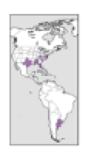
Concept explainers
A New Cause of Spots

Fifty-two-year-old David has a good life. After 30 years serving the country as an Army officer, he has retired to the Texas Gulf Coast-a region of large oaks, mild winter weather, and great outdoor spaces. It’s a great place to retire and enjoy hiking through the woods and meadows photographing wildlife. It would be nearly perfect if some of the wildlife didn't bite. Ubiquitous ants, pesky mosquitoes, and bloodsucking ticks seem to always be on the prowl.
It’s a tick that brings him to his doctor today. The thing had bit him on his left shoulder, resulting in a huge boil that swelled and drained pus, though the lesion doesn’t hurt at all. His primary care physician doesn’t appear to be too concerned and prescribes amoxicillin for the boil.
Three days later, David is back but feeling much worse. He has suddenly developed fever, headache, muscle pains, fatigue, and an alarming rash over most of his body. The physician now suspects Rocky Mountain spotted fever (RMSF), though it’s relatively rare in Texas, and orders a laboratory test using anti-Rickettsia rickettsii antibodies. The test comes back negative; David is not infected with R. rickettsii. He does not have RMSF. The doctor takes a skin sample from the infected area and prescribes 100 mg of doxycycline twice daily for two weeks.

The rash resolves in a week, and further polymerase chain reaction (PCR) testing on bacteria found in the sample of skin reveals R. parkeri. In the United States, the Gulf Coast tick, Amblyomma maculatum, is the vector for this bacterium that was long thought to be harmless to humans. David is one of the first of several dozen patients to tangle with this pathogen that is emerging as a threat in the southeast United States and in Argentina.
- 1. Why didn’t the antibody test show infection?
- 2. What is PCR testing?
- 3. In a
Gram-stained sample of David's skin, what color would the rickettsias be?
Want to see the full answer?
Check out a sample textbook solution
Chapter 19 Solutions
EBK MICROBIOLOGY:W/DISEASES BY BODY...-
- AaBbCc X AaBbCc individuals are crossed. What is the probability of their offspring having a genotype AABBCC?arrow_forwardcircle a nucleotide in the imagearrow_forward"One of the symmetry breaking events in mouse gastrulation requires the amplification of Nodal on the side of the embryo opposite to the Anterior Visceral Endoderm (AVE). Describe one way by which Nodal gets amplified in this region." My understanding of this is that there are a few ways nodal is amplified though I'm not sure if this is specifically occurs on the opposite side of the AVE. 1. pronodal cleaved by protease -> active nodal 2. Nodal -> BMP4 -> Wnt-> nodal 3. Nodal-> Nodal, Fox1 binding site 4. BMP4 on outside-> nodal Are all of these occuring opposite to AVE?arrow_forward
- If four babies are born on a given day What is the chance all four will be girls? Use genetics lawsarrow_forwardExplain each punnet square results (genotypes and probabilities)arrow_forwardGive the terminal regression line equation and R or R2 value: Give the x axis (name and units, if any) of the terminal line: Give the y axis (name and units, if any) of the terminal line: Give the first residual regression line equation and R or R2 value: Give the x axis (name and units, if any) of the first residual line : Give the y axis (name and units, if any) of the first residual line: Give the second residual regression line equation and R or R2 value: Give the x axis (name and units, if any) of the second residual line: Give the y axis (name and units, if any) of the second residual line: a) B1 Solution b) B2 c)hybrid rate constant (λ1) d)hybrid rate constant (λ2) e) ka f) t1/2,absorb g) t1/2, dist h) t1/2, elim i)apparent central compartment volume (V1,app) j) total AUC (short cut method) k) apparent volume of distribution based on AUC (VAUC,app) l)apparent clearance (CLapp) m) absolute bioavailability of oral route (need AUCiv…arrow_forward
- You inject morpholino oligonucleotides that inhibit the translation of follistatin, chordin, and noggin (FCN) at the 1 cell stage of a frog embryo. What is the effect on neurulation in the resulting embryo? Propose an experiment that would rescue an embryo injected with FCN morpholinos.arrow_forwardParticipants will be asked to create a meme regarding a topic relevant to the department of Geography, Geomatics, and Environmental Studies. Prompt: Using an online art style of your choice, please make a meme related to the study of Geography, Environment, or Geomatics.arrow_forwardPlekhg5 functions in bottle cell formation, and Shroom3 functions in neural plate closure, yet the phenotype of injecting mRNA of each into the animal pole of a fertilized egg is very similar. What is the phenotype, and why is the phenotype so similar? Is the phenotype going to be that there is a disruption of the formation of the neural tube for both of these because bottle cell formation is necessary for the neural plate to fold in forming the neural tube and Shroom3 is further needed to close the neural plate? So since both Plekhg5 and Shroom3 are used in forming the neural tube, injecting the mRNA will just lead to neural tube deformity?arrow_forward
 Medical Terminology for Health Professions, Spira...Health & NutritionISBN:9781305634350Author:Ann Ehrlich, Carol L. Schroeder, Laura Ehrlich, Katrina A. SchroederPublisher:Cengage Learning
Medical Terminology for Health Professions, Spira...Health & NutritionISBN:9781305634350Author:Ann Ehrlich, Carol L. Schroeder, Laura Ehrlich, Katrina A. SchroederPublisher:Cengage Learning- Understanding Health Insurance: A Guide to Billin...Health & NutritionISBN:9781337679480Author:GREENPublisher:Cengage
 Comprehensive Medical Assisting: Administrative a...NursingISBN:9781305964792Author:Wilburta Q. Lindh, Carol D. Tamparo, Barbara M. Dahl, Julie Morris, Cindy CorreaPublisher:Cengage LearningEssentials Health Info Management Principles/Prac...Health & NutritionISBN:9780357191651Author:BowiePublisher:Cengage
Comprehensive Medical Assisting: Administrative a...NursingISBN:9781305964792Author:Wilburta Q. Lindh, Carol D. Tamparo, Barbara M. Dahl, Julie Morris, Cindy CorreaPublisher:Cengage LearningEssentials Health Info Management Principles/Prac...Health & NutritionISBN:9780357191651Author:BowiePublisher:Cengage





